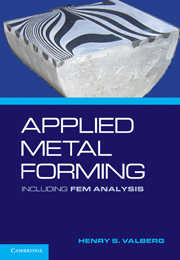Book contents
- Frontmatter
- Contents
- Preface
- APPLIED METAL FORMING
- 1 Characteristics of Metal Forming
- 2 Important Metal Forming Processes
- 3 FEA of Metal Forming
- 4 Theory
- 5 Reduction and Proportions of the Plastic Zone
- 6 Deformations from the Velocity Field
- 7 Technological Tests and Physical Simulation
- 8 Flow Stress Data
- 9 Formability and Workability
- 10 Friction and Friction Models
- 11 Thermal Effects
- 12 Experimental Metal Flow Analysis
- 13 Theoretical Methods of Analysis
- 14 Finite Element Analysis
- 15 FEA of Technological Tests
- 16 Forging
- 17 FEA of Forging
- 18 Extrusion
- 19 FEA of Extrusion
- 20 Rolling
- 21 FEA of Rolling
- 22 Drawing of Wire, Profiles, and Tubes
- 23 FEA of Wiredrawing
- 24 Sheet-Metal Forming
- Index
- References
13 - Theoretical Methods of Analysis
Published online by Cambridge University Press: 05 June 2012
- Frontmatter
- Contents
- Preface
- APPLIED METAL FORMING
- 1 Characteristics of Metal Forming
- 2 Important Metal Forming Processes
- 3 FEA of Metal Forming
- 4 Theory
- 5 Reduction and Proportions of the Plastic Zone
- 6 Deformations from the Velocity Field
- 7 Technological Tests and Physical Simulation
- 8 Flow Stress Data
- 9 Formability and Workability
- 10 Friction and Friction Models
- 11 Thermal Effects
- 12 Experimental Metal Flow Analysis
- 13 Theoretical Methods of Analysis
- 14 Finite Element Analysis
- 15 FEA of Technological Tests
- 16 Forging
- 17 FEA of Forging
- 18 Extrusion
- 19 FEA of Extrusion
- 20 Rolling
- 21 FEA of Rolling
- 22 Drawing of Wire, Profiles, and Tubes
- 23 FEA of Wiredrawing
- 24 Sheet-Metal Forming
- Index
- References
Summary
It is important – as shown in the preceding chapters – to be able to predict the deformations and the metal flow in metal forming with sufficient accuracy. The importance of knowing such factors as the pressure against the die and the required forming load was early recognized by the metal former. Much work was therefore done to develop theoretical models that could be used to predict these parameters, so that they could be estimated with sufficient accuracy before a new process was set up. The theoretical models established for this purpose showed that the forming load depended on such factors as die geometry and friction, for instance, and in hot forming also on the forming speed. With the development of theoretical methods, it also became possible to calculate the effect of each factor on the forming load.
There are a number of theoretical methods that can be used for analyzing metal forming processes; see Table 13.1. In the following sections, they will be described, except for the slip line field and the finite difference methods, which have been described elsewhere. The information that can be obtained by the different methods is specified in Table 13.1. Additional written material that describes the application of the slip line theory for analysis of metal forming and compares it with corresponding analysis by FEA is available at www.cambridge.org/valberg.
The Uniform Energy Method
The uniform energy method is the simplest method.
- Type
- Chapter
- Information
- Applied Metal FormingIncluding FEM Analysis, pp. 204 - 218Publisher: Cambridge University PressPrint publication year: 2010



